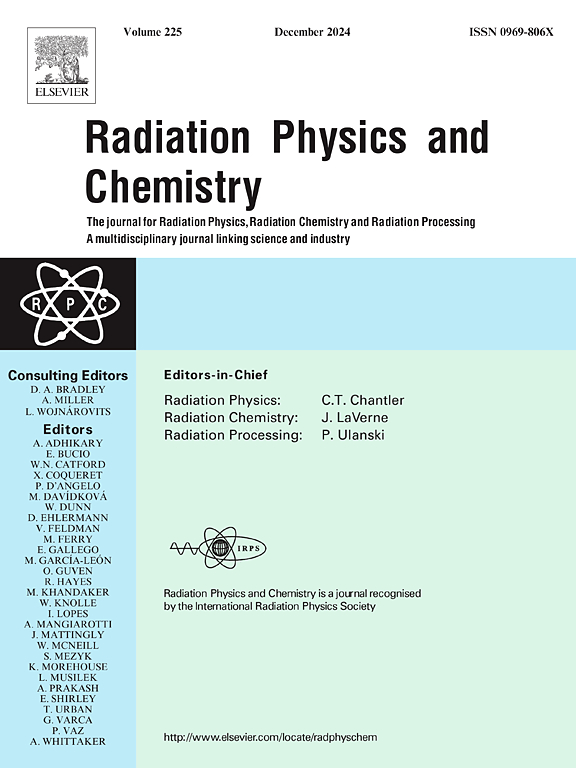基于蒙特卡罗模拟的反康普顿散射源对纳米粒子剂量增强的微观评价
IF 2.8
3区 物理与天体物理
Q3 CHEMISTRY, PHYSICAL
引用次数: 0
摘要
纳米粒子放射治疗已被广泛研究,显示出能量依赖的性能。迫切需要提供能量可调谐x射线的紧凑型放射治疗设备。逆康普顿散射(ICS)源可以提供准单色和连续的能量可调谐x射线,可以优化各种纳米材料的辐射增强效果。本研究使用Geant4在微尺度上模拟了ICS源的增强放疗。对典型纳米材料金纳米粒子(GNPs)的辐射增强效果进行了评价,并与传统x射线管进行了比较。建立改进的肿瘤模型,评价GNPs和氧化铪纳米粒子的显微剂量增强因子(DEF)。纳米粒子的DEF具有能量依赖性,在36 keV单色光束下,GNPs的最大DEF为17.89。ICS源在38 keV时显示出类似的DEF(17.77)性能,由于带宽较窄,高于80 kV x射线管(12.80)。改进的模拟方法表明,GNPs在30 keV下的DEF为22.8,而氧化铪纳米粒子在25 keV下的DEF为9.5。ICS源在最佳能量下具有更高的DEF,可用于增强放疗。其连续能量可调谐特性使其成为应用不同纳米材料增强放射治疗的理想设备。本文章由计算机程序翻译,如有差异,请以英文原文为准。
Microscopic evaluation of nanoparticle dose enhancement by inverse Compton scattering source using Monte Carlo simulation
Radiotherapy with nanoparticles has been widely investigated, showing an energy dependence performance. A Compact radiotherapy facility providing energy-tuneable X-rays is highly demanded. Inverse Compton Scattering (ICS) sources can offer quasi-monochromatic and continuous energy-tuneable X-rays, enabling optimization of radiation enhancement effect for various nanomaterials. This study simulated enhanced radiotherapy with an ICS source using the Geant4 at microscale. The radiation enhancement effect of a typical nanomaterial, i.e., gold nanoparticles (GNPs), was evaluated and compared with the conventional X-ray tube. An improved model of tumors was built to evaluate the microscopic dose enhancement factor (DEF) of different nanoparticles, including GNPs and hafnium oxide nanoparticles. DEF of nanoparticles showed an energy dependence and the largest DEF of GNPs was 17.89 at 36 keV with monochromatic beams. The ICS source displayed a similar performance in terms of DEF (17.77 at 38 keV), which was higher than the 80 kV X-ray tube (12.80), due to the narrow bandwidth. The improved simulation method showed that the DEF was 22.8 for GNPs at 30 keV and 9.5 for hafnium oxide nanoparticles at 25 keV. The implementation of the ICS source, with a higher DEF at optimal energy, is feasible for enhanced radiotherapy. The continuous energy-tuneable property makes it a promising equipment for the application of enhanced radiotherapy with different nanomaterials.
求助全文
通过发布文献求助,成功后即可免费获取论文全文。
去求助
来源期刊

Radiation Physics and Chemistry
化学-核科学技术
CiteScore
5.60
自引率
17.20%
发文量
574
审稿时长
12 weeks
期刊介绍:
Radiation Physics and Chemistry is a multidisciplinary journal that provides a medium for publication of substantial and original papers, reviews, and short communications which focus on research and developments involving ionizing radiation in radiation physics, radiation chemistry and radiation processing.
The journal aims to publish papers with significance to an international audience, containing substantial novelty and scientific impact. The Editors reserve the rights to reject, with or without external review, papers that do not meet these criteria. This could include papers that are very similar to previous publications, only with changed target substrates, employed materials, analyzed sites and experimental methods, report results without presenting new insights and/or hypothesis testing, or do not focus on the radiation effects.
 求助内容:
求助内容: 应助结果提醒方式:
应助结果提醒方式:


